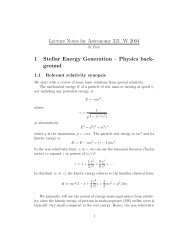Lecture Notes for Analog Electronics - The Electronic Universe ...
Lecture Notes for Analog Electronics - The Electronic Universe ...
Lecture Notes for Analog Electronics - The Electronic Universe ...
You also want an ePaper? Increase the reach of your titles
YUMPU automatically turns print PDFs into web optimized ePapers that Google loves.
to produce an output which is proportional to shifts in phase of the input. Since one can<br />
consider the modulation of the carrier to be a phase shift (by amount ωmt), the output<br />
of the PLL can then produce a voltage signal proportional to these phase shifts, which in<br />
turn is used to provide active rectification of the input at the frequency of the modulation.<br />
<strong>The</strong> essential non-linear behavior of the diode discussed above is provided in this case by an<br />
active voltage multiplier. This type of PLL circuit is actually more relevant to FM detection,<br />
which is discussed below.<br />
8.3.4 Superheterodyne Detection<br />
This technique is illustrated in the text, pages 895-6. It is essentially a fancy version of our<br />
simple heterodyne detector above. In this case, the simple passive LC bandpass filter at the<br />
input is replaced by a local oscillator and mixer. An example is given in Figure 13.41 of<br />
the text. Consider an input carrier of frequency 10 MHz which has amplitude modulated at<br />
some much lower frequency. This signal is mixed with a local oscillator of fixed frequency<br />
greater than the carrier. In the example of the text, the local oscillator has frequency tuned<br />
to be fLO =10.455 MHz, exactly 455 kHz greater than the carrier. As with our earlier diode<br />
example, the mixed signal includes the difference frequency, in this case 455 kHz, which in<br />
turn has nearby sideband frequencies which differ from 455 kHz by the audio modulation<br />
frequencies. From this point on, the detection is carried out as in the simple heterodyne<br />
example. One advantage here is that a relatively high-frequency carrier, which in general<br />
will be difficult to condition using conventional electronics is effectively reduced to a more<br />
manageable frequency, in the example from 10 MHz to 455 kHz. <strong>The</strong> other advantage is<br />
that the band-pass tuning which follows the mixer is always centered at a constant 455 kHz.<br />
So the tuning is accomplished by adjusting the oscillator, rather than the filter.<br />
8.4 Other Modulation Schemes<br />
Recall from Eqn. 45 that <strong>for</strong> AM the amplitude is modulated by varying the frequency ωm.<br />
However, to preserve the in<strong>for</strong>mation, the generation and receipt of the amplitude must be<br />
linear. In addition, most noise sources will naturally appear as voltages, and hence will add<br />
to the AM signal. On the other hand, phase and frequency modulation (FM) do not suffer<br />
from these complications. Hence, where fidelity is important, these schemes have intrinsic<br />
advantages. Radio broadcast by FM also has the additional advantage, by dint of historical<br />
accident, of occupying a higher frequency band, thus allowing easy accomodation of a full<br />
audio bandwidth. However, unlike the AM radio band, the FM band signals do not reflect<br />
from the ionosphere, and there<strong>for</strong>e can not be transmitted over very large distances (at<br />
night).<br />
8.4.1 Phase Modulation<br />
A carrier of frequency ωc is phase modulated if the resulting signal has the <strong>for</strong>m<br />
V (t) =V0cos(ωct + Ap cos ωmt) (47)<br />
where V0 and Ap are constants and ωm is the modulating frequency, as be<strong>for</strong>e. This can be<br />
expanded, and <strong>for</strong> Ap ≪ 1 can also be simplified:<br />
V (t)/V0 = cosωct cos(Ap cos ωmt) − sin ωct sin(Ap cos ωmt)<br />
51













